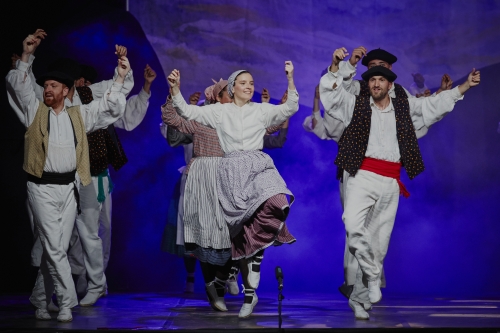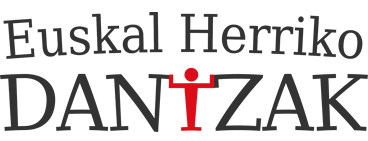Human battles, divine struggles
- Pablo A. Martín Bosch. "Aritz".
- 15/ 10/ 2001
Tool dances in the Basque Country include those which are carried out with swords or crossbows as well as those in which staffs or bows are employed, although exactly how is unknown.
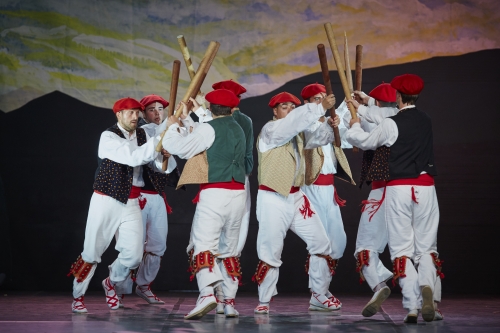
The province of Bizkaia thus has the entire cycle series of the Dantzari Dantza of the Duranguesado, which are carried out in different manners. It is also home to that of the Xemein, which includes short staffs of the type used in Carnival and in the Dance of the Pelts, also called Zaragi or Zagi Dantza. Finally, there is the Dance of the Lanestosa Arches, still used in traditional exhibitions.
Before continuing with this analysis, it is important to point out that the series of dances known as Dantzari Dantza include, at the very least, the following elements. First, a dance of presentation before the authorities (Agintariena), in which the dancers wear all the typical attire and carry the full equipment, including their swords and staffs. Second, a series of dances related to the number of people that take part (all of them, one by one, in twos, in threes - according to Humboldt - and in fours) and in which the swords are either held by the dancers or worn on one side, but in both cases form part of the dance.
Third, dances in which sword itself is used to strike and in high and low defence, as in the case of the two weapons games. Fourth, a dance of staffs, in which the steps and the figures expressed in the weapons games seem to be repeated, although carried out with staffs or long, thick poles. In the opinion of some authors there is another dance, which perhaps is the one which puzzles researchers the most as it has been performed at times and rejected at others. On some occasions this dance concludes with a dancer being lifted above the heads of two of his companions and on others it has been carried out in a different way, dancing again and each dancer returning to his original position after executing some steps and figures which are today are still the subject of controversy. In addition, this entire performance is generally followed by the Soka Dantza or rope dance, which is carried out in a semicircle and is of mixed sexes and of a social nature. In this dance two dancers pay their respects to the ladies, after which they danced the Fandango and the Ariñ Ariñ, classified by diverse authors as high or low dances. Nonetheless, we cannot forget that at times they have also presented bow dances (Gorulari) and sash dances (Domingillue). This completes a series of dances that are difficult to identify both in their order and in the importance of the different performances.
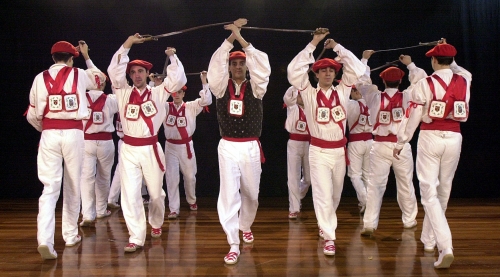
Regarding the Xemein or Arretxinaga sword dances, these are group exhibitions that begin in the traditional two-row formation. They finish in the formation of the "rose" or platform of swords, on which they place a dancer. This includes a duel between two "ezpata txikiak" or "ezpata txin" as is done in the towns of neighbouring province of Gipuzkoa. Finally, the captain gets down off his pedestal and rejoins the group, the "rose" comes apart and then they dance, as mentioned before, the Soka Dantza, the Fandango and the Arin Arin.
The pelt dances constitute a different group of dances which are typical of Carnival. While the group of men perform a variety of skillful moves with small staffs, another group bears a wineskin. The latter group is violently driven out of the choreography at the last moment.
Finally, the Bow dances of Lanestosa have the same structure as the sword dnaces in the form of a pavilion as they are performed in Xemein, though in this case there are more similarities and a closer geographical relationship to the province of Santander and the region of Cantabria.
We are aware that each performance must be interpreted or understood not only in its geographical context, which involves studying the its relationship to the surrounding towns and the modifications and new ideas that are thus added, but also in its ideological context. The latter favours the magical and religious aspect, allowing us to obtain an idea of the festival to which it is dedicated or its purpose, as well as giving clues as to what magical connotations it has. This aspect should be analyzed, step by step, in each and every dance that is performed in the feudal territories.
However, researchers of this subject have usually chosen to offer general explanations that allow us an overall understanding of the purpose of the tool dances. From this variety of researchers and interpretations we have selected those which we consider to be closest to our objective, which is to explain the origin of the tool dances.
Tool Dances associated with warrior activities
If we regard the wealth of interpretations provided about the purpose of the tool dances from a historical point of view, we find the association with war in the first place. During the end of the 19th and beginning of the 20th centuries, different authors from Bizkaia and Gipuzkoa have come to the conclusion that there is a direct relationship between the tool dances and those exercises which are necessary for warrior activities. The series of dances of Dantzari Dantza called Ezpata Joko Txikia, Ezpata Joko Nagusia and Makil Jokoa or Makil Dantza fit in perfectly with this interpretation. This would be a demonstration by the local inhabitants before the captain to show their willingness to defend the territory. This theory is strengthened by the dance of salute to the flag or Agintariena, seen as a show of obedience to the authorities.
This is the opinion of K. DE HERMODO, J.I. IZTUETA (in Gipuzkoa), and Segundo DE OLAETA
Tool Dances linked to the natural reproductive cycle
Lucile ARMSTRONG, as opposed to her professor Violet ALFORD and her predecessor, Curt SACHS, offers the following interpretation: the sword dances (and thus the tool dances) fulfill a magical need to restore the natural order and to awaken the forces of Nature embodied in its different aspects. The staff or pole, as her professor said, was used to plant and has become part of popular imagery in the form of a magic wand in fairy tales. In addition, when this is transformed into a sword, as interpreted by Curt SACHS, it does not lose its original symbolism upon becoming a dance typical of an Iron Age society; instead it reinforces its original function. If the staff or pole represents the fecundating cavity, which also implies the awakening of the sleeping forces of Nature - the noise created when the instruments hit each other highlight this function. The swords are used for this because they produce more noise than the staffs or poles and are therefore more effective in awakening the forces of Nature. Moreover, when we interpret it in this way it explains why the sword dances are not always present in mining areas or why they do not always perform them in these areas.
Tool Dances interpreted as dances of an Iron Age society
Thirdly, we find studies that link, one way or another, the sword dances to rituals characteristic of blacksmith associations.
The hypothesis is that the sword dances must have arisen in areas where iron and steel had age-old importance.
From anthropological data we known, or believe to know, that the blacksmiths had a series of rituals which permitted neophytes to become initiated. We thus reach the conclusion that the sword dances cannot be fully likened to the staff dances, or that the staff dances must have been substituted by the sword dances because they held more magic. That is, the sword dances only replaced the staff dances in areas where they could create "natural" swords - areas where forging took place.
Lucile ARMSTRONG, among others, opposes this hypothesis.
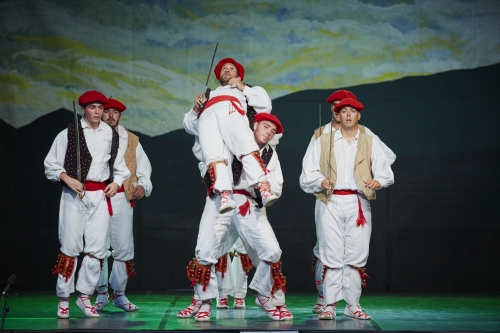
Tool Dances understood as curative or medicinal rituals
Some authors have preferred to interpret the sword and staff dances as medicinal dances. The main hypothesis is that these dances helped to cure people. L. GIL and Marius SCHNEIDER suggest that curing involves the symbolic death of the sick person, as might occur in the Txakarrenkua or Txotxongillo, in which the dancer "dies" and is then "brought back to life".
In the more "primitive" societies or those without written expression the sorcerer or medicine man used a series of rituals and medicinal plants which might seem amusing in our modern-day society, but in their time they were seen as traditional medicine or at least as proven curing methods. Among them were savageries such as hanging rocks or weights from the breasts of the women of Bizkaia to soften them for breasfeeding.
In the case of the sword dances, and thus probably in the rest of the dances performed with weapons, the dances which involve the "death" and "resurrection" of one of their members might symbolize the death and resurrection of the illness, as can now be seen in the evolution of these dances.
On the other hand, this would mean that we would accept an anthropological hypothesis, currently questioned on the base of the evolution of civilizations following the Western European model, as being accurate.
We cannot and will not deny the possible prophylactic use of the tool dances, but we do wish to express our doubts regarding this interpretation.
Tool Dances seen as rituals of shamanic initiation
Investigators who have lately been attracted more by the magical and symbolic aspects that may have existed in the tool dances have chosen to orient their analysis along sociological or ethnological lines, using the studies of Mircea ELIADE as their fundamental base.
Thus, following the abovementioned parameters, Txema HORNILLA concludes that the sword dances embody some type of shamanic religious thinking in which the shaman comes back to life following a period in trance.
In this way the sword or tool dances, more specifically those in which a dancer "dies" (Txotxongillo) or "dies symbolically" (Ezpatadantza de Xemein) alongside certain figures of the Zuberoa carnival, may demonstrate the prior existence of a shamanic religion in the Basque Country.
We feel obliged to present our objections to this hypothesis for two reasons. First, the information backing it does not appear to respond to the interests of the author because Mircea ELIADE herself reduces the area where shamanism took place to Eastern Europe and the southern United States, even doubting its existence in classical Greece and Rome. Second, the evidence which backs her main theory confuses, in our opinion, the figure of the shaman or medicine man with that of the sorcerer. This confusion of terms leads us to needlessly extend the area of influence of the shamanic religion beyond its real limits.
Tool Dances interpreted as rites of initiation or passage
Finally, our hypothesis consists of the following: the tool dances include two main components. The human performances have served to meet human needs of fighting and war which, at the same time, represent opposition to a social and political system forced on them.
The weapons dances, like any others, have been prohibited or criticized by political, military and religious authorities because they embodied a society's opposition to an established order. During Franco's regime in the Spanish government the traditional dances were another show of resistance to the idea of a Unified State.
Furthermore, the tool, sword and staff dances have served as displays of submission to these authorities, as is seen in the dances performed for monarchs, mayors and all types of religious authorities. In this case the groups of young people danced to show their obedience to the appropriate authority.
However, from our point of view behind the preceding individual interpretations there is a more profound vision which is associated with the magical world which has given rise to them. We are thus faced with a different point of view in which earthly matters are secondary in importance. In this is new area of interpretation the Dantzari Dantza, for example, would no longer represent the presentation of an armed group of men before the authority, but rather before a deity. Later a series of dances would be performed to arrange the original chaos (everyone dances at the same time: Zortzinango), into the primordial Unity (Banango), the duality (Binango) and finally the perfect order associated with the number four (Launango) in which everything is finally situated (the four cardinal points, etc.).
This interpretation would coincide with those offered by other authors since it would be the starting point for any initiation rite, whether it be a festival dedicated to agriculture, livestock breeding, rites of initiation for blacksmiths or shamans, medicinal dances or any other celebration or ritual. What remains, then, is to clarify the ultimate meaning of the exhibitions in terms of the dances which are performed afterwards.
In the first place, in order to establish our hypothesis in this case we rely on a series of events which take place before, during and after the dances themselves, which are:
Moving away from the social group to an area of open ground reminds us of an act of marginalization characteristic of the rites of initiation described by Arnold Van GENNEP. The debates which are established between former dancers allow us to think that the dances are not simply coincidence and are the result of a specific ritual.
The meetings around coffee or tea that take place following the debates have a table layout similar to that of other, more "primitive" areas where they continue to carry out rites of initiation for young people.
The fact that those who participate in the dances come from their home villages and their age group is another indicator that these are rituals of societies dominated by young people.
The placing of the post at nightfall or during the night by dancers who have not yet worn their full attire of the "big day" allows us to link this feat to the show of force that is characteristic of such rituals. Dancing with women in the Soka Dantza traditionally involves doing so with grown-up women. This is, in a way, a form of recognition because the male dancer is thus also considered to be an adult.
The performance of the bridges, as seen in the Soka Dantza and whose interpretation follows that of our anthropologists, reinforces the hypothesis that both the men and the women who participate in the Soka should be considered honest and of adult age. In other words, they are completely entitled to participate in the dance. The exhibitions that take place on the "big day" need to be researched more in depth in order to understand their symbolism.
However, the fact that they are performed once again a week later may be related to a desire to prolong the festive period. Moreover, a festival called "Dantzari Berriyen Egune" or "Day of the New Dancers" obliges us to take into account that who was not a (male) dancer before in a given moment (before the selection) now is. A process of selection is thus completed and the boy becomes a man.
What is the purpose, then, of the different dances? The question is not easily answered. There is, as previously mentioned, a presentation before the deity who is represented by a flag, which serves as a totem and a symbolic archtype. We also have a series of dances related to the numbers 8, 1, 2 and 4 (excluding the hirurco mentioned by HUMBOLDT) which takes us back to Chaos, the Unity, the Duality and the Four that symbolically represents the established Order. Thus, as in baptism, we have been born again to recreate what has occurred.
The Sword and Staff dances, int he Dantzari Dantza, follow the same model; the first can be reduced to the second. The sword and staff dances have the same structure, which leads us to suppose that the two sword dances are continued in the staff dances in order to break the monotony of the series that we believe to be the origin of the Dantzari Dantza. Therefore, we think that the two sword performances in the Dantzari Dantza have been put into the series later in order to break the monotony of the exhibition and that it is the origin of the Agintariena, Zortzinango, Banango, Binango and Launago.
What are the rest of the dances for? Joxemiel de BARANDIARAN tells us that man is traditionally believed to have made the sun rise by beating the hilltops with large staffs. This allows us to think that in the traditional customs the staff was not only a defensive weapon but also had a symbolic role as the sun (Nature) came out through it. The staff dances, then, may well have served as magic to tell the "day star" where it should be. We thus speak of magic more than science. Other authors have spoken of cases in which the sticks or staffs have been used to plant and that the hitting of them together would wake up the forces of nature. In our opinion, this strengthens the interpretation we have offered; the blows of the staffs and swords were used to symbolically prepare the harvest time.
In the case of the ribbon dances, all the authors who have been consulted seem to agree that the post represents nature and the ribbons of leaves that are strung from them or the doll (Dominguillue) represent Nature's potential abilities. This is also represented by cabbage and other vegetables that open up to free doves, flowers, etc.
Finally, the dance of the Txotxongillo is the most difficult to interpret. Here we see that the dancer "dies" symbolically to never wake up again (Txakarrenkua) or to return to life and occupy his primordial place (Txotxongillo). The term "txotxongillo" seems to derive from the handling of the dancer as if he were a doll ("txotxongilo") and the dancer then appear as a doll over the heads of the rest of the group, who are thought to be a type of coffin made around him. What does the doll in the form of a flesh and blood dancer represent, then?
As we have seen above it may simply be a ceremony performed by a spiritual guide or a warrior, such as those from northern Europe, in honour of a fallen leader. In other words, the dance might be an expression of mourning before a certain chief or warrior. This is the oldest interpretation, having existed since the 19th century.
The Txotxongilo or "doll" might have represented a certain time such as the death of a year and the birth of another, without having to correspond to a natural or ecclesiastic year. The festive year dies, as in the case of the Burial of the Sardine or the Mari Jaia in Bilbo, to make way for a new period.
It may also represent the death of Carnival and its posterior rebirth, as occurs in many spots all over Europe.
